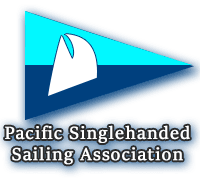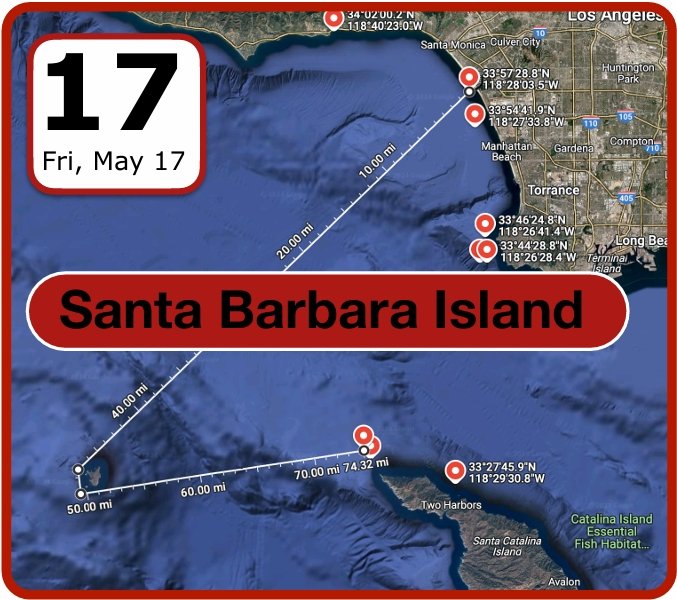Catalina to Port. By Greg Rosenkrans
Illustration by Jeff Rosenkrans
It all started a few days before — before the PSSA single and double-handed race around Catalina. I paused and thought, “Will it be a good day? Will I have enough gas to travel half way around the Island if something breaks? What if the wind dies completely? Never mind all the rigging and racing setup. What’s the wind going to do on the day of the race and more importantly, what’s on the menu for lunch and dinner?”
Welcome to PSSA where some very good sailors on the West Coast are quietly doing their thing. We prefer the single/double handed format of yacht racing where skippers recluse themselves of all the hassles of outfitting a fully crewed boat. Simplicity, smartly rigged boats and thoughtful boat handling skills bring back the pure essence of what sailing is really all about. Competitors at sea, we are also a tight knit group where the bravado and banter on the water is friendly and contagious. We talk more story than truths during our monthly meetings at Pacific Mariners Yacht Club. The yacht races are more like rallies where victory is merely rewarded with post-race bragging rights. Usually the winner is roasted, than toasted, then congratulated at the trophy presentations.
Sailing to Catalina is no small feat. Racing single handed or double handed around the backside of the island in the open ocean is a whole other animal. As I left the dock at 8 a.m. for the 11 a.m. start off Palos Verdes, Calif., I was enjoying the motor out of the harbor — glassy and sunny. My boat, a J29, hardly left a wake going 6.5 knots out the channel. Another competitor, a new Hanse 37 Cassiopeia, was much like the constellation readying to be a lead marker on the course today. As we motored out together, I heard the coxswain calling out cadence as the eight-man Cal Yacht Club rowing team flew by in a determined stride. I thought about the race, sail plan, and wind conditions all while motoring out to the head of the breakwater. Joining up with the other PSSA boats we had formed a procession like pelicans in their early morning ritual riding the wave tops in synchronized formation. Our heading is south towards Palos Verdes, which lie some 15 miles ahead. I gave a friendly wave to the starting boat, “the rabbit,” which on this day was a Newport 41. This sailboat is a 1980s era boat with a good reputation for being a stout cruiser/racer. The boat is a classic and timeless C&C design. There were 12 boats entered in this yacht race— six in the single handed class and six in the double handed class.
With all the boats simultaneously preparing and completing final sail adjustments, I decided that the light #1 genoa would be the right headsail to start with. I also made sure my main had the reefing line run and ready to go, expecting a windy afternoon as that was in the latest NOAA weather radio forecast. “What spinnaker will I use,” came to mind next. I rigged up another spin sheet and an outside jib lead on the port side just in case there is a wind shift that required me to crack off at the West End. Luckily I had all the course positions already plotted into my trusty handheld GPS. I think we rely too much on the GPS. Heck, I’m not exactly sure what the magnetic course is from Palos Verdes to the West End of Catalina. My GPS tells me everything: course, speed, VMG, even the expected time of arrival. I do have paper charts and a slide ruler but who uses those things anyway. My thoughts were on more pressing things like that big alpha 44-footer named Distraxion, which is throwing in a practice tack right in the starting area. This boat is a beautiful and fast X Yacht, an Xp44. I think the “P” stands for perfect.
The PSSA starts are very exciting with all sorts of things going on at the same time. The right away boat, the rabbit, starts on Port tack and everyone must pass his stern. The problem with that is you can have really fast big boats going for the stern of the rabbit while simultaneously you have really quick and maneuverable small boats competing for the same space and position. Makes for some friendly prestart banter. Generally, though, everyone is very courteous and seamanlike at the start. There is no need to be aggressive at the start – it’s a 41-mile race! My start was just fair. I was the third boat to cross the rabbit and tack over onto port tack, heading north by northwest. My competition, just ahead of me, was an ultra sporty Mini 6.5 21’ boat with a 40’ mast, Biohazard. Make no mistake, this boat is really fast and has been clocked at over 20 knots surfing downwind! The other boat just ahead and to leeward was Rubicon III, a Contessa 33 that always does well in all sorts of wind conditions. This is a very well sailed boat, and an even better skipper to compete with.
About one third of the way up the first beat heading towards the West End of Catalina several boats tacked over onto Starboard. Now the fun starts. Should I do a loose cover or stick to the game plan? I stick to the game plan till I cannot stand it anymore and tack over onto Starboard again to “keep contact” with my competition. Looks like the wind is getting light up ahead on Starboard tack. Oh heck, I tack back onto Port to take my chances. By the time I tack back onto Starboard again I was aiming at Parsons landing, the point of land just below the West End. My GPS says six miles to go. All looked good until 30 minutes later as I am lifted above the West End. Now all the competition is lifting up inside me and able to lay the West End. Luckily, there is more wind further out and I reach the West End in third place overall, just ahead of the competition.
The wind suddenly gets light, really light, and the pod of boats are all sniffing out for the next puff in all directions — on Port, on Starboard and from close hauled to beam reach. Bummer! Now what? I watch a few boats decide enough is enough. Now I am in second place but contemplating motoring to Cat Harbor when the wind suddenly starts to fill in and the pod of boats become like slow moving rockets each blasting off catching the new wind at a blistering three knots. It’s like a slow moving speed chase with my competition in hot pursuit.
The wind begins to fill in nicely and the fleet starts hoisting their spinnakers one by one. It’s a nice sail for a bit, a very short bit at that. Just when everything is going so well the wind starts to pipe up dramatically, at first increasing from eight to 10 knots, then 12, then 15, then 18 knots and more. What to do? My heart starts pounding and my thoughts quickly turn toward how to get the spinnaker down fast and without shrimping it in the water. The takedown is not exactly pretty. I enveloped the lazy spinnaker sheet between the boom and the foot of the mainsail. This type of takedown kept control of the sail and allowed me to drop my asymmetrical spinnaker in 25 knots of wind without major incident. Good grief, I am relieved the spinnaker is safely down and I sail onto the finish wing on wing. The finish line coordinates are one-half nautical mile off Catalina’s East End light at 350 degrees magnetic. At that precise point, bearing and heading you cross the imaginary finish line out at sea. I record my eight and one-half hour race and time into the ship’s log: P to C finish time at 19:38:23.
A few bruises, a sprained wrist and a post race beer made the voyage all the more memorable. It was a glorious night with no moon present. The wind just shutdown and the stars abounded in applause for another PSSA race has just been completed. I was savoring this time and this moment knowing it could never be recaptured. At 34 miles offshore from the mainland and blocked by Catalina’s majestic cliffs, there was no ambient city lights. So dark you couldn’t see your hand in front of you except for the stars that dazzled brilliantly above. Looking out toward the western night sky I felt as if I were instantly transported 1,000 miles offshore. It was brilliant. It was amazing. It was fabulous.
I reluctantly began to motor onto Avalon Harbor which was beckoning my arrival to nurse a battered body that just endured a full day of yacht racing against other boats, sails, sea and wind. The Harbor Patrol escorted me to my mooring. Avalon in spring is quiet at night and the air is cool and crisp with that distinctive ocean scent that only occurs when sea meets land. Making way to my bunk I was already thinking about next year’s race around Catalina and dosed off into a deep sleep within the safe confines of Avalon Harbor knowing… it was a good day.



Photos by Margie Woods



